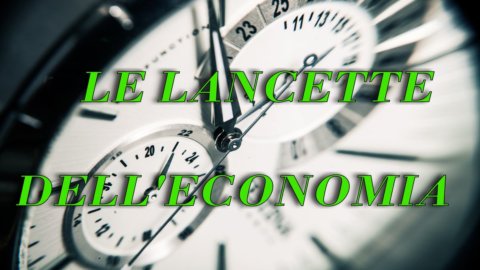- advanced indicators luckily they continue to advance. Both the confidence indexes of consumers and those of businesses portend a smooth continuation of the recovery, and, perhaps for the first time, the risks are upwards and not down.
I consumption, as soon as restrictions are eased and vaccinations are increased, they will be able dash forward. As long as there isn't a spanner in the works.
The stick on duty is found in the chips, now ubiquitous in consumer and investment goods. In the bestiary of recessions there are those from weak demand and those from supply constraints. There possible chip recession adds a new one: supply constraints due to too much demand.
The virus has exploded the demand for dial-up chips, and, because of the lack of production capacity and the inevitable slowness in setting up new 'fabs', chips are scarce. Car manufacturers (modern cars are now 'computers on wheels') have in some cases had to slow down production due to lack of chips. Fingers crossed.
On both sides of the Atlantic the new ones infections are in clear retreat. But the terrible case ofIndia it reminds us of a bitter truth: we will not be safe from a resurgence of SARS-CoV-19 until it is eradicated everywhere. Sending vaccines to the countries that need them most is not charity, but intelligent selfishness. President Biden's initiative by remove patent protection from vaccines it is noble but questionable.
The fact that the coincident and leading indicators give good news on the economy is positive. Even because chorality in good expectations it means that the quantum of recovery will be more than the sum of the parts (and this is the main reason that leads us to believe that the risks are upwards).
But – there is a 'but' – the aftermath of the crisis is and will be heavy. If, before the virus, one of the most worrying features of the world economy was the increase in inequalities, the ongoing health crisis has put salt on wounds. Both practice and grammar confirm that new hotbeds of inequality formed – by geographical area, by sector, by age group, by type of employment contract… – and also the impressive support measures could not be calibrated properly: they supported Trilussa's average but they have left uncovered pockets of poverty and large sectoral niches.
As has always been said, the main variable for monitoring the exit from the virus is the vaccinations. These continue and often accelerate. But levels of vaccine protection are unequal, although increasing everywhere. The percentage (compared to the population) of those who have received at least one dose is very high (75%) in the USA and the United Kingdom, between 25 and 40% in the countries of the Eurozone, but only 15% for the world whole (India: 12%).
The case of Seychelles is a warning: the archipelago has only 100 inhabitants, and has been able to vaccinate over 60% of the population. But he just had to reimpose the restrictions due to the emergence of many new cases. As mentioned last month, the danger is the same as always: progress in infections leads to relaxation, and relaxations lead to new infections. Looking ahead, it is possible and likely that the coronavirus will remain endemic, forcing us to annual reminders, as is already the case with its close relative, the flu virus.
Last month we said, about inflation, that some extra pressure is to be expected, if not even desirable. AND the 'extra pressures show in the data. Apart from the temporary factors already mentioned (VAT in Germany, revision of the price basket in the Eurozone…) there is, in the trend rate, a comparison with the months of 2020 when the impact of the virus on the economy was maximum and prices they cooled.
But there are also non-occasional factors of increase: the prices of raw materials (by now we must also consider the chips among these) are in tension for the increase in demand in the two main absorbers – USA and China – which are also the two economies most advanced in the recovery. However, while supply response is slow in the case of chips, this is not the case for other commodities, and price tensions should be reabsorbed.
For now, the tensions are strong: compared to a year ago, when the crisis was raging, non-oil raw materials recorded increases of almost 50%, and oil of 80 percent. But at the level of consumer prices, which are also exceeding the famous 2%, the repercussions are modest and, as already mentioned, i structural factors which keep the lid on inflation, are strong and long lasting.
The tensions on consumer and production prices will go away to be reflected in rates? US Treasury Secretary, Janet Yellen, stumbled on the communication and said that rates will rise in line with the recovery, even if he then half reneged on the externalization. The Fed chairman Powell he has long said that even if inflation rises, they will not change monetary policy, given that the 2% inflation target should be considered as the cycle average, and if before it was, let's say, 1%, even if it went to 3% there would be no consequences (Trilussa would have had nothing to say).
And indeed the markets have maintained an Olympian calm. The rates of T Bond to 10 years (which, in addition to worrying about inflation, should in theory also worry about the public deficit monstre American) even dropped compared to last month, when they exceeded 1,70%; I'm now below 1,60. On the other hand, the yields of the Waist, only in the sense that they became a little less negative.
Lo spreads with BTPs it rose to 110, confirming that when rates rise, they rise a little more in Italy than in Germany. However, the spread remains below pre-Draghi levels (it had exceeded 120 in January). The level of returns of the btp, around 0,90%, is historically low, and, thanks to the purchases of the ECB, significantly lower than that of T-Bonds).
I real rates they haven't changed much. They keep below zero in both Germany in that Use (which is a comfort to the economy) and are back above zero in Italy (hopefully because of the improved growth prospects).
For the you change, rate differential, nominal or real, has changed against the dollar, which may explain the return towards 1,20 against the euro. But structural factors are also at play. As the IMF states, the share of the dollar in the foreign exchange reserves of the rest of the world is decreasing. In the fourth quarter of 2020, it fell to 59%, the lowest level in 25 years.
The growing role of alternative currencies plays, among which the yuan must also be counted. The US financial sanctions have also had an influence, according to the "law of unintended consequences": they have prompted the sanctioned (but also the sanctionable) to create payment channels that do not go through the dollar, from simple barter to bilateral agreements whereby two countries agree to pay and be paid in their own currencies.
Despite the growth differential in favor of the dollar, no upward jerks of the greenback are to be expected. The yuan it also appreciated against the US currency, and is now at 6,45 – the strongest level since 2018 and about 9% better than a year ago.
I stock markets, as mentioned last time, remain on nice stable. The only cloud on the horizon is in the aforementioned shortage of chips which could lead to an abnormal recession. But the automakers – and they are already doing it – could work around it with 'chip-lite' models – after all, the drawings and specifications already have them in the drawers – and the same can be said for other chip-intensive products. Human ingenuity should never be underestimated…
Le alternative remain unattractive to equity investment, despite slight rate hikes. L'gold you look at the navel and the cryptocurrency They are for roller coaster lovers…





